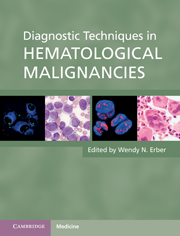Book contents
- Frontmatter
- Contents
- List of Contributors
- Preface
- Part 1 Diagnostic techniques
- Part 2 Hematological malignancies
- 6 The integrated approach to the diagnosis of hematological malignancies
- 7 Acute lymphoblastic leukemia
- 8 Acute myeloid leukemia
- 9 Mature B-cell leukemias
- 10 Mature T-cell and natural-killer cell leukemias
- 11 Lymphoma
- 12 Plasma cell neoplasms
- 13 Chronic myeloid leukemia
- 14 Myeloproliferative neoplasms
- 15 Myelodysplastic syndromes and myelodysplastic/myeloproliferative neoplasms
- Index
- References
14 - Myeloproliferative neoplasms
from Part 2 - Hematological malignancies
Published online by Cambridge University Press: 06 December 2010
- Frontmatter
- Contents
- List of Contributors
- Preface
- Part 1 Diagnostic techniques
- Part 2 Hematological malignancies
- 6 The integrated approach to the diagnosis of hematological malignancies
- 7 Acute lymphoblastic leukemia
- 8 Acute myeloid leukemia
- 9 Mature B-cell leukemias
- 10 Mature T-cell and natural-killer cell leukemias
- 11 Lymphoma
- 12 Plasma cell neoplasms
- 13 Chronic myeloid leukemia
- 14 Myeloproliferative neoplasms
- 15 Myelodysplastic syndromes and myelodysplastic/myeloproliferative neoplasms
- Index
- References
Summary
Introduction
The myeloproliferative neoplasms (MPNs) are a group of clonal stem cell disorders with similarities at the phenotypic and molecular level. Clinically these disorders are characterized by over-production of one or more mature myeloid elements and a variable tendency to develop acute myeloid leukemia (AML). Polycythemia vera (PV), essential thrombocythemia (ET) and primary myelofibrosis (PMF) overlap clinically and share a tendency to undergo phenotypic shift, such that patients with ET may develop PV, and ET or PV may undergo myelofibrotic transformation. A degree of phenotypic overlap is also seen in patients with chronic eosinophilic leukemia (CEL) and systemic mastocytosis (SM). At the molecular level, the myeloproliferative neoplasms are characterized by dysregulated tyrosine kinase signaling due to localized mutations (affecting JAK2, MPL or KIT) or chromosomal rearrangements (affecting ABL1, PDGFRA/B or FGFR1). Chronic myeloid leukemia (CML) has been discussed separately in Chapter 13.
Polycythemia vera
Epidemiology and pathogenesis
Polycythemia vera is characterized by over-production of erythrocytes, a variable increase in granulocytes and/or platelets and a risk of thrombotic and hemorrhagic complications. The annual incidence is around 1–2.5 per 100 000 population, with a peak between 50 and 70 years of age, and a slight male predominance. Polycythemia vera may be diagnosed by chance, following a thrombotic event or during investigation for symptoms such as pruritus, gout, headaches or visual disturbance. Thrombotic complications are the main cause of morbidity and mortality.
- Type
- Chapter
- Information
- Diagnostic Techniques in Hematological Malignancies , pp. 283 - 306Publisher: Cambridge University PressPrint publication year: 2010



